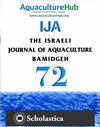Treatment of leachate solid wastewater and protein-rich biomass production using Ceratophyllum demersum (Linnaeus, 1753)
IF 0.5
4区 农林科学
Q4 FISHERIES
引用次数: 0
Abstract
The present study, conducted in 2018, aimed to treat landfill leachate using the Ceratophyllum demersum plant and convert the wastewater nutrients into protein-rich biomass. The experiment was carried out for 45 days in an enriched medium with ½ Hoagland nutrient solution. Regarding the experimental setups, C. demersum cultivation was performed in four different dilution ratios (100%, 75%, 50%, and 25%) in the landfill leachate. The changes in the chemical properties of the wastewater (pH, NO₄⁻-N, NO₂⁻-N, NO₃⁻-N, and o-PO₄³⁻) were measured. The values in the leachate and after treatment were measured as follows: NH₄⁺-N ranged from 18.03 to 476.2 mg/L, NO₃⁻-N ranged from 5.0 to 33.98 mg/L, NO₂⁻-N ranged from 1.49 to 7.06 mg/L, and PO₄³⁻-P ranged from 27.99 to 145.4 mg/L. The protein yield (CP prot) in the experimental groups at the end of the 45-day study was as follows: T1 = 20.90%, T2 = 36.68 %, T3 = 41.78%, T4 = 47.43% and T5c = 49.56%. These results demonstrate that aquatic plants can be utilized in wastewater treatment and as animal feed due to their high protein yield. In my research, a completely nature-friendly treatment technique was used to reduce water pollution without using any chemicals.利用角藻(Ceratophyllum demersum)处理渗滤液固体废水和生产富含蛋白质的生物质(Linnaeus, 1753)
本研究于2018年进行,旨在利用角藻植物处理垃圾填埋场渗滤液,并将废水营养物质转化为富含蛋白质的生物质。试验在加1 / 2 Hoagland营养液的培养基中进行,为期45天。在实验设置方面,以四种不同稀释比例(100%、75%、50%和25%)在垃圾渗滤液中培养夏貂。测定了废水的化学性质(pH、NO₄⁻-N、NO₂⁻-N、NO₃⁻-N、o-PO₄⁻)的变化。渗滤液中和处理后的值测量如下:NH₄⁺-N的范围从18.03到476.2 mg/L, NO₃⁻-N的范围从5.0到33.98 mg/L, NO₂⁻-N的范围从1.49到7.06 mg/L, PO₄³⁻-P的范围从27.99到145.4 mg/L。45 d研究结束时,各试验组蛋白质产量(CP prot)分别为:T1 = 20.90%, T2 = 36.68%, T3 = 41.78%, T4 = 47.43%, T5c = 49.56%。这些结果表明,水生植物因其高蛋白产量可用于废水处理和动物饲料。在我的研究中,使用了一种完全自然友好的处理技术来减少水污染,而不使用任何化学物质。
本文章由计算机程序翻译,如有差异,请以英文原文为准。
求助全文
约1分钟内获得全文
求助全文
来源期刊
CiteScore
0.90
自引率
16.70%
发文量
49
审稿时长
3 months
期刊介绍:
Information not localized

 求助内容:
求助内容: 应助结果提醒方式:
应助结果提醒方式:


